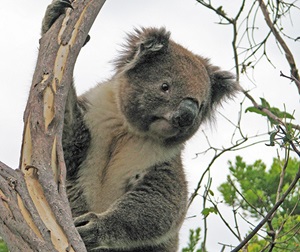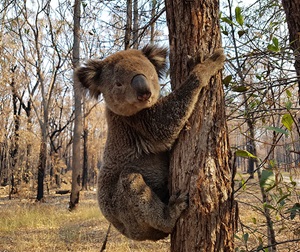The koala is listed as a vulnerable species in New South Wales under the Biodiversity Conservation Act 2016. Reviews of population trends have indicated that most koala populations in New South Wales are declining.
The NSW Koala Strategy (the strategy) was developed in 2018 to 'stabilise and then start to increase koala numbers and ensure genetically diverse and viable populations across New South Wales'. One action detailed under the 'building our knowledge' pillar of the strategy was developing a statewide, cross-tenure monitoring program in partnership with other agencies.
Developing a statewide monitoring program
Monitoring plays an important role in the conservation management of threatened species. It is essential to understand the drivers of decline, evaluate management effectiveness, and provide evidence to support policy. In addition, long-term data are required to establish baselines, detect and evaluate trends in populations and increase predictive capacity.
The NSW Koala Monitoring Framework (the framework) has been developed to provide an overall structure for long-term koala monitoring in New South Wales. It advocates a consistent, best practice approach that, if fully implemented, will provide reliable information on population trends and indicators of population health. The main way to determine the effectiveness of the strategy is to monitor koala populations.


 The primary objectives of the framework are to:
The primary objectives of the framework are to: Effective monitoring of koalas must occur over multiple koala generations and for long enough to detect trends. While this framework focuses on the first 10 years, it is necessary to continue monitoring koalas well past this timeframe to gain an understanding of their response to changes in habitat (both losses from land use changes and gains from conservation actions), their resilience to extreme events (e.g. fire and drought), their ability to persist in the face of changing climate, and the effectiveness of management actions.
Effective monitoring of koalas must occur over multiple koala generations and for long enough to detect trends. While this framework focuses on the first 10 years, it is necessary to continue monitoring koalas well past this timeframe to gain an understanding of their response to changes in habitat (both losses from land use changes and gains from conservation actions), their resilience to extreme events (e.g. fire and drought), their ability to persist in the face of changing climate, and the effectiveness of management actions. The extended 2019-20 bushfire season impacted a significant area of koala habitat. We are yet to fully understand the impact on koala numbers, particularly given that populations had already been under stress from ongoing drought conditions since early 2017. Monitoring koalas over time at burnt and unburnt sites will improve our knowledge of how populations recover to better prepare for and manage the impacts of future events.
The extended 2019-20 bushfire season impacted a significant area of koala habitat. We are yet to fully understand the impact on koala numbers, particularly given that populations had already been under stress from ongoing drought conditions since early 2017. Monitoring koalas over time at burnt and unburnt sites will improve our knowledge of how populations recover to better prepare for and manage the impacts of future events.